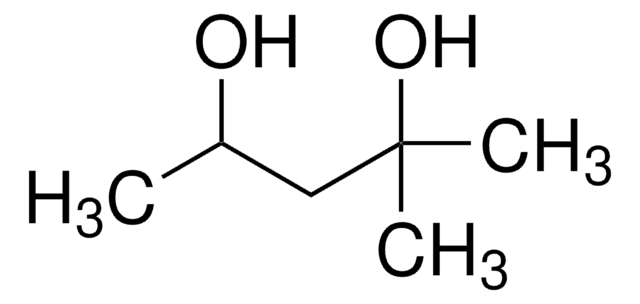68338
Hexylene glycol
BioUltra, ≥99.0% (GC)
Synonym(s):
(±)-2-Methyl-2,4-pentanediol, MPD
About This Item
Recommended Products
vapor density
4.1 (vs air)
vapor pressure
0.02 mmHg ( 20 °C)
product line
BioUltra
Assay
≥99.0% (GC)
form
liquid (or viscous liquid)
expl. lim.
7.4 %
impurities
insoluble matter, passes filter test
refractive index
n20/D 1.427 (lit.)
n20/D 1.428
pH
6-8 (25 °C, 1 M in H2O)
bp
197 °C (lit.)
mp
−40 °C (lit.)
solubility
H2O: 1 M at 20 °C, clear, colorless
density
0.925 g/mL at 25 °C (lit.)
anion traces
chloride (Cl-): ≤50 mg/kg
sulfate (SO42-): ≤50 mg/kg
cation traces
Al: ≤1 mg/kg
As: ≤0.1 mg/kg
Ba: ≤1 mg/kg
Bi: ≤1 mg/kg
Ca: ≤5 mg/kg
Cd: ≤1 mg/kg
Co: ≤1 mg/kg
Cr: ≤1 mg/kg
Cu: ≤1 mg/kg
Fe: ≤1 mg/kg
K: ≤20 mg/kg
Li: ≤1 mg/kg
Mg: ≤1 mg/kg
Mn: ≤1 mg/kg
Mo: ≤1 mg/kg
Na: ≤20 mg/kg
Ni: ≤1 mg/kg
Pb: ≤1 mg/kg
Sr: ≤1 mg/kg
Zn: ≤1 mg/kg
λ
1 M in H2O
UV absorption
λ: 260 nm Amax: 0.01
λ: 280 nm Amax: 0.01
SMILES string
CC(O)CC(C)(C)O
InChI
1S/C6H14O2/c1-5(7)4-6(2,3)8/h5,7-8H,4H2,1-3H3
InChI key
SVTBMSDMJJWYQN-UHFFFAOYSA-N
Looking for similar products? Visit Product Comparison Guide
Other Notes
Signal Word
Warning
Hazard Statements
Precautionary Statements
Hazard Classifications
Eye Irrit. 2 - Repr. 2 - Skin Irrit. 2
Storage Class Code
10 - Combustible liquids
WGK
WGK 1
Flash Point(F)
201.2 °F - closed cup
Flash Point(C)
94 °C - closed cup
Personal Protective Equipment
Certificates of Analysis (COA)
Search for Certificates of Analysis (COA) by entering the products Lot/Batch Number. Lot and Batch Numbers can be found on a product’s label following the words ‘Lot’ or ‘Batch’.
Already Own This Product?
Find documentation for the products that you have recently purchased in the Document Library.
Our team of scientists has experience in all areas of research including Life Science, Material Science, Chemical Synthesis, Chromatography, Analytical and many others.
Contact Technical Service






